Article recounts the early days and residents of LeDroit Park
A Bloomingdale resident share this 1937 news story in which the author recounts the early days and residents of LeDroit Park.
The writer describes what LeDroit Park looked like before 1875, which is about the time the neighborhood started to develop. He recalls that he could stand at 7th Street and Florida Avenue (née Boundary Street) and see all the way down to North Capitol Street.
Few houses stood on Florida Avenue at that time, he notes. The Washington & Georgetown Railroad, a streetcar company, kept a car barn on the triangular block opposite what is now the Howard Theatre.
The neighborhood was created by combining the Miller, Prather, McClelland, and Gilman properties pictured below. The Prather property was used as a pasture and the Miller property was not maintained.
The wood and iron fence, which caused a great dispute in the 1880s, extended from the neighborhood’s boundary at 2nd Street to within a few feet of 7th Street. “At the west of the grounds is an attractive old gate, made to match the artistic fence. It was evidently driveway gate, though its use as such has been abandoned and the driveway itself obliterated.”
Early residents
The author lists several of the neighborhood’s earlier residents. Before LeDroit Park became the favorite enclave of Washington’s black elite, it housed many prominent whites. While few of the people listed below are household names today, many of them held high positions in government.
- Henry Gannett, Chief Geographer, U.S. Geological Survey, and described as the “Father of Government Mapmaking“
- Rep. Benjamin Butterworth, House of Representatives (R-OH) and Commissioner of Patents
- Arthur A. Birney, U.S. Attorney for the District of Columbia
- Col. O. H. Irish, Chief, Bureau of Engraving and Printing
- Sumner I. Kimball, General Superintendent, U.S. Life Saving Service, forerunner to the U.S. Coast Guard
- William T. Hornaday, Chief Taxidermist, U.S. National Museum (now called the Smithsonian) and controversial director of the Bronx Zoo
- Arnold B. Johnson, Chief Clerk, U.S. Lighthouse Board
- Edmund Wood, Chief of the Financial Division, Bureau of Indian Affairs
- De Lancey Gill, painter and photographer, Smithsonian Bureau of American Ethnology
- George S. Prindle, patent attorney
- Ellery C. Ford, lawyer (This name appears at the African-American Civil War Memorial on U Street)
- Andrew Langdon, co-developer of LeDroit Park
- James H. McGill, architect of LeDroit Park and other Washington buildings
- Staughton S. Doyle, music teacher
- Ezra B. Barnum, clothier and grand juror who indicted Charles Guiteau, who assassinated Pres. James Garfield in 1881
- Dr. Joseph N. Rose, botanist
- J. J. Albright, possibly the wealthy coal magnate and associate of LeDroit Park developer Amzi Barber.
- Capt. Howard L. Prince, Civil War captain and Librarian of the U.S. Patent Office
- George E. Sloat, employee of the Pension Office
- Charles Ruoff, partner, Willet & Ruoff
- Marie Ginesi, employee of the Post Office
- Charles Darwin (no, not that Charles Darwin), librarian, U.S. Geological Survey
- W. Scott Smith, correspondent, New York Times
Here are names I haven’t been able to research:
Brenton L. Baldwin, Emma B. Smith, F. H. Ramey, W. E. Williams, Ralph Baldwin, B. Pettingill, S. S. Gannett, F. J. Young, Henry A. Merrick, Rev. C. H. Fay, N. M. Brush, Charles W. Fisher, Abram L. Swartout, W. Norman Fleming, Charles A. Hamilton, O.B. Brown, William H. Degges, W. F. Hildebrand, James A. Marter, T. B. Campbell, T. J. W. Robertson, E. M. Merrick, H. B. Wyman, M. Horstman, A. W. Conlee, C. R. Follin, Mary Ragan, Oscar T. Towner, E. Woodruff, W. Hollingsworth, H. E. Cooper, and J. B. Thomas.
If you dig up any information on these people, please add it to the comments.
LeDroit house enjoys an unmatched view
A recent open house in LeDroit Park perfectly illustrated a great feature of the L’Enfant Plan. The house at 469 Florida Avenue sits directly on the New Jersey Avenue view corridor of the Capitol. Typically this location would be reserved for a civic monument such as a statue, circle, square, or government building, but L’Enfant drew his capital within the confines of Florida Avenue, the two rivers, and Rock Creek.
In some cases, such as Rhode Island, New York, and Maryland Avenues in Northeast, Massachusetts and Connecticut Avenues in Northwest, East Capitol Street, and Pennsylvania Avenue SE, subsequent city officials and developers continued these avenues beyond the city’s original boundary.
LeDroit Park, however, stood right in the way of what could have been an extended New Jersey Avenue NW. Instead of terminating the avenue at a civic point, builders in the neighborhood’s rowhouse era (1880s and after), built without regard to the design principles of the L’Enfant Plan. The result is that one row house has a stunning Capitol view worthy of a monument.
LeDroit Park demographics in the 1890s
 Though the Constitution mandates a decennial census, the District’s police force undertook its own census, presumably to balance deployments through the growing city.
Though the Constitution mandates a decennial census, the District’s police force undertook its own census, presumably to balance deployments through the growing city.
The 1892 and 1895 police census tables, reported in the Evening Star, showed LeDroit Park growing 37% in those three years. Furthermore, the neighborhood was slowly becoming more diverse as the whites accounted for 96% of the population in 1892, but 91% in 1895.
Though LeDroit Park was established as an exclusively white neighborhood, by 1910 the neighborhood had become almost entirely black.
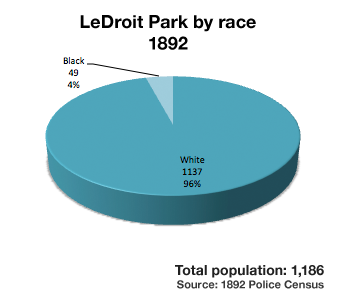

Despite these pendulum swings, LeDroit Park’s demography is more diverse today.
Reminder: Free history walking tour of LeDroit Park this weekend


Come on out Saturday or Sunday for a free history walking tour of LeDroit Park. I conduct this tour annually as part of WalkingTown DC.
The tours will be on Saturday, October 5 at 1 pm and again on Sunday, October 6 at 10 am. Meet me at the arch at 6th Street and Florida Avenue NW. The tours are free and open to the public. No reservations are required.
We’ll cover
- The neighborhood’s founding
- Relationship with the Howard Theatre
- Architectural history
- The Park at LeDroit
- Walter Washington
- Ernest Everett Just
- Robert & Mary Church Terrell
- Anna Julia Cooper
- William Birney
- Edward Brooke
- Octavius Williams
- Oscar De Priest
- Griffith Stadium
Get a free history tour of LeDroit Park on Oct. 5 & 6
How was LeDroit Park established and who built all those unique homes on U Street? Why did the neighborhood start as exclusively white but become important to black history? As part of the annual WalkingTown DC event, I will lead two free walking tours of the neighborhood.
The tours will be on Saturday, October 5 at 1 pm and again on Sunday, October 6 at 10 am. Meet me at the arch at 6th Street and Florida Avenue NW. The tours are free and open to the public.
We’ll cover
- The neighborhood’s founding
- Relationship with the Howard Theatre
- Architectural history
- The Park at LeDroit
- Walter Washington
- Ernest Everett Just
- Robert & Mary Church Terrell
- Anna Julia Cooper
- William Birney
- Edward Brooke
- Octavius Williams
- Oscar De Priest
- Griffith Stadium
LeDroit streets get a slurry seal
A few streets became much darker yesterday evening. Throughout the day yesterday, DDOT applied a “slurry seal” to the surface of several neighborhood streets. The slurry seal is a type of liquid asphalt that is sprayed from the back of a truck and smoothed out by road workers. According to DDOT, the material “seals cracks on existing roads and protects the roadway surface from occurrences that cause normal wear and tear, thus slowing down the deterioration rate of the pavement.”
Here’s a photo of truck applying the material to 5th Street. The white stop line, granite crosswalk line, and various utility holes were covered in removable tape to prevent them from being paved.
The truck now applies the final strip of slurry. Notice how shiny it is when it’s freshly poured:
Here’s a close-up of a freshly poured section. The ends have to be manually smoothed out and feathered by road workers.
The seal runs over onto the brick gutter in a few places, but it otherwise smoothes over the cracks and cuts in the street pavements. The streets now sport a fresh, even surface like a freshly frosted cake.
Speaking of asphalt, did you know that the man who founded LeDroit Park later became the “asphalt king” of America? LeDroit Park was founded in 1873 by Amzi Barber, who quit Howard’s Board of Trustees to go into real estate in DC. After a decade, Barber quit the real estate and started a business to spread a new technology: asphalt road paving. Though it seems ubiquitous now, it wasn’t until the late 19th century that governments started paving streets with asphalt. In 1888 Barber moved his asphalt business to New York, where it took off. He was so successful that his 1909 obituary in the New York Times described him as the “man who founded the asphalt industry in this country.”
Sunday & Monday events in LeDroit Park
There are several upcoming LeDroit park events.
Sunday: LeDroit Park historical walking tour
As part of the annual WalkingTown DC event, I will lead two free walking tours of the neighborhood. The tours will be on Sunday, September 30 at 1 pm and again at 3:30 pm. Meet me at the arch at 6th Street and Florida Avenue NW. The tours are free and open to the public.
Monday: Monthly LeDroit Park happy hour
Come for drinks, free appetizers, and chat with your neighbors Monday, October 1 from 6 to 8 at Nellie’s (9th & U Streets NW). Nellie’s owner, a LeDroit Park resident, has kindly donated appetizers for the event.
Get a free history tour of LeDroit Park on Sept. 30
How was LeDroit Park established and who built all those unique homes on U Street? Why did the neighborhood start as exclusively white but become so important to black history? As part of the annual WalkingTown DC event, I will lead two free walking tours of the neighborhood.
The tours will be on Sunday, September 30 at 1 pm and again at 3:30 pm. Meet me at the arch at 6th Street and Florida Avenue NW. The tours are free and open to the public.
We’ll cover
- The neighborhood’s founding
- Relationship with the Howard Theatre
- Architectural history
- The Park at LeDroit
- Walter Washington
- Ernest Everett Just
- Robert & Mary Church Terrell
- Anna Julia Cooper
- William Birney
- Edward Brooke
- Octavius Williams
- Oscar De Priest
- Griffith Stadium
Storm floods streets and basements of Bloomingdale
During torrential downpours the Bloomingdale neighborhood experiences flooding. Yesterday evening’s storm flooded numerous Bloomindale basements and the intersection of Rhode Island Avenue, T Street, and First Street NW.
The Boundary Stone restaurant (116 Rhode Island Avenue NW) posted a photo of a flooded Rhode Island Avenue NW.
Why did this section of the street flood? DC Water, which runs the water pipes, sewers, and storm drains, blames the lack of pipe capacity in Bloomingdale.
A closer look at the 1861 Boschke map of the District of Columbia reveals that the northern reaches of Tiber Creek flowed right through Bloomingdale. In fact the creek flowed right where Rhode Island Avenue flooded at T Street NW.

Boschke map with modern streets superimposed
Whether the creek still flows underground in this location is something I will leave to experts. However, creeks, like all water, flow to the lowest point on the land. The creek’s former presence at this location suggests that the terrain slopes downward on all sides, directing rainwater to this critical flood point.
Ward 5 Councilmember Kenyan McDuffie (D) was on the scene and DC Water has promised to brief him soon on their Bloomingdale flood solution, which they say is on the way. Though this degree of flooding is rare, Bloomingdale residents will surely welcome and demand a permanent fix.
The death of FormStone
Formstone, that faux-stone façade that became popular in the 1930s and ’40s, can be removed, but it’s not easy. The old Frazier’s Funeral Home, at 389 Rhode Island Avenue, has been vacant for several years since the District shut it down. The new owner is renovating the property to convert into 4 or 5 residential units.
Part of the renovation involves removing the Formstone façade and repairing the brick beneath.

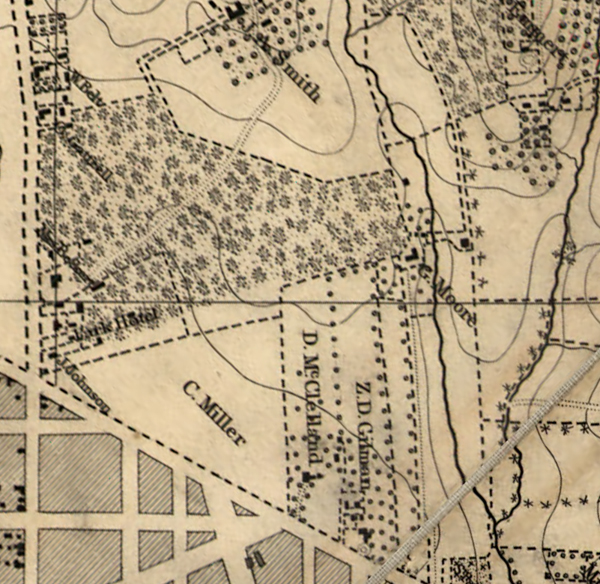
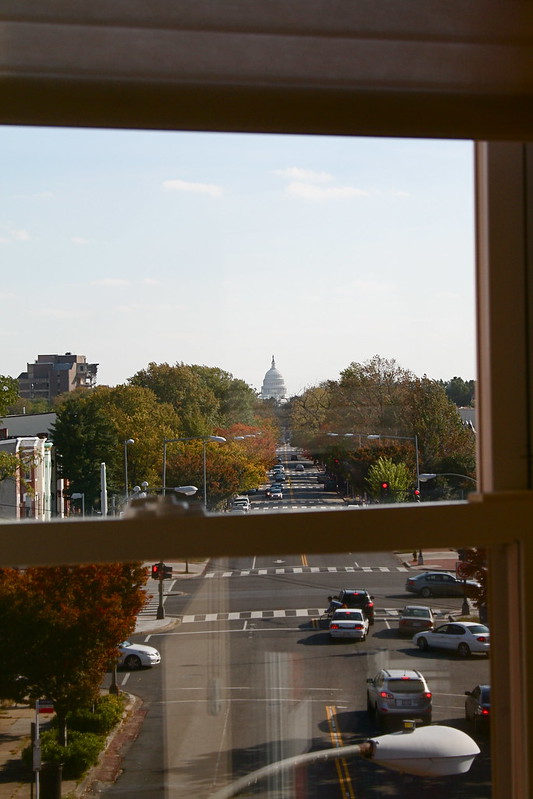



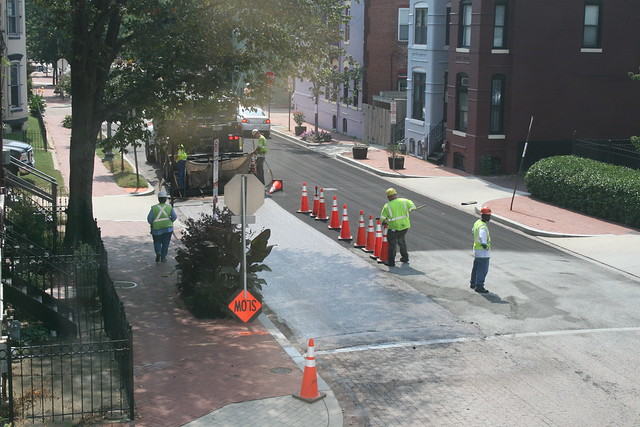
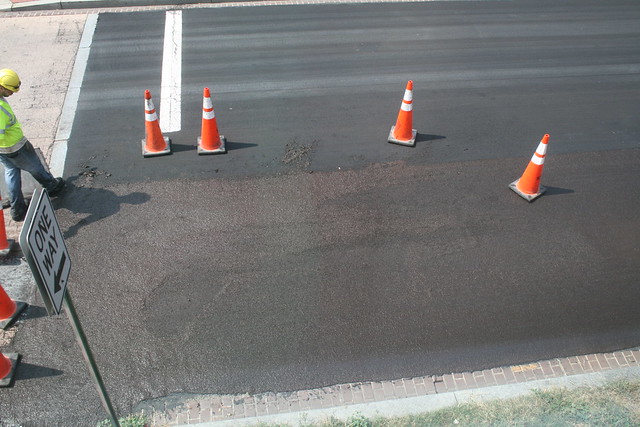

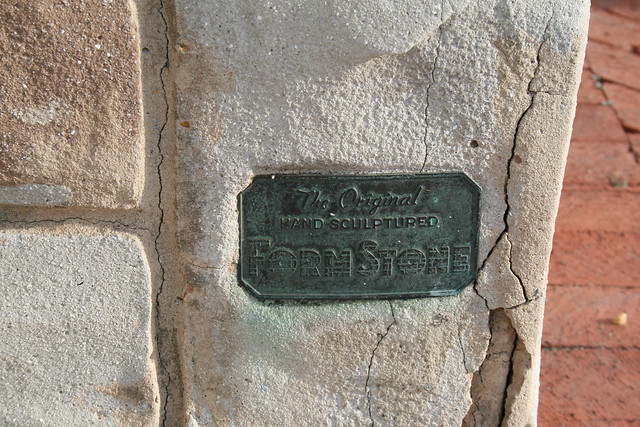

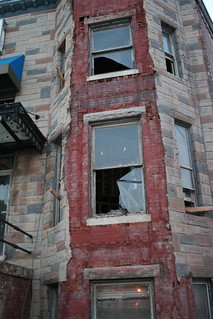
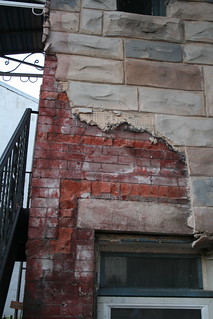






Recent Comments